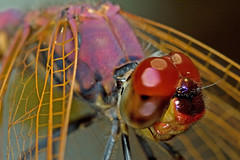Last year I spent a lot of time at Lago deAverno (lake of Averno) shooting dragonflies. There are several species of them but the most common is the Violet Darter in the photo. After a while you start to pick up on their habits and quirks, and you learn when you can get close and when you're wasting your time. The trick is to find one that's busy. If they are feeding, mating, or otherwise occupied then they are less likely to fly away. If they do fly off then just freeze -if the dragon comes back to the same spot (or close to it) then try again. If the critter lands several meters away from you then look for a new subject to shoot.
You won't get close if it keeps moving away from you.
If you try to get close to a dragonfly and it takes off then simply freeze, or back up a step and freeze. If the critter comes back to the same perch then odds are it didn’t take off because of you; it found something to eat and went after it. The trick is to move slowly and don’t vary your pace. Predators often move slowly at first, but speed up for the strike. Photographers often move slow at first but get excited as they get close to the subject –and the critter will take off because you’re moving like a predator…
Now that you’re getting close the dragonfly is getting use to you, and it’s not viewing you as a predator. So take your time and compose your shots carefully so you won’t feel the need to crop them later during post processing. If the dragon takes off just wait and see if it comes back. If you are very close (within inches / a few centimeters) then you might have to back up a little to get the dragonfly to come back to the same perch. Just keep your movements slow and even and when it lands move back in. Patience is the key to taking photos of dragonflies above life size –get into too big of a hurry and you’ll go home empty handed…
I normally go shooting in the heat of the day, when dragonflies are the most active and when I have a better chance of finding one that’s feeding (or a mating pare). If there is a particular species that won’t let you get close, or that seems to be constantly in motion, then go looking for it early in the morning when it’s still trying to dry out from the previous night’s dew.
I take almost all of my photos using either a flash as fill or as the primary light source, so the light from the flash doesn’t seem to bother them. The only trouble I’ve had with flash photography is getting so close to a dragonfly that I accidentally touched it with the flash ;)
I never wear bright clothes when I go shooting insects. I think it helps to blend in a little with the area where I’m shooting, so I try to stick to neutral colors. Grey is almost always a safe bet, but any color that comes close to the reeds, trees, and other plants that they perch on will help.
Be patient, be persistent, and push your luck. I dedicated that photo to Mark Plonsky -I got the inspiration to try my luck at getting really close after seeing one of his images. The glass on my lens was less than 13 centimeters (5 inches) away from the dragonfly. Shot hand held with a 20D, 100mm macro lens, 37mm of extension tubes (for 1.6 times life size) and an MT-24 macro flash.
Practice, lots of practice... ;)


5 comments:
Oh yeah, this :D It's really informative, thanks for sharing. And I agree very much on the patience part ... LOL :) Thanks!
Hope it helps :)
FANTASTIC guide! Ever so helpful! I only have one decent successful dragonfly photo series.... excellent shots on flickr as well!
Do you have any other great guides?
Thanks Brian :)
I have a tutorial gallery at Deviant Art that I keep up to date: http://dalantech.deviantart.com/gallery/#Tutorials
Regards,
John
Post a Comment